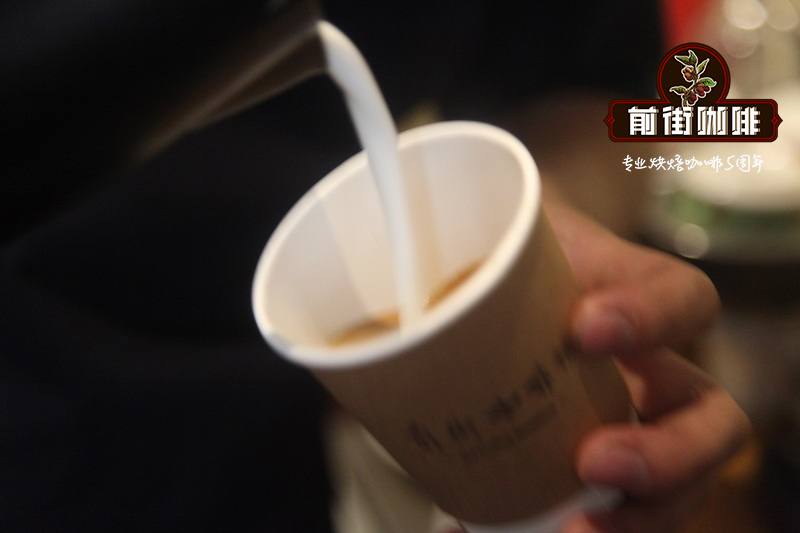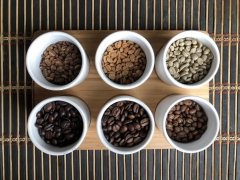Italian matching coffee bean recommendation _ Qianjie Italian matching coffee bean formula public _ blending coffee bean price

Professional coffee knowledge exchange more coffee bean information please follow the coffee workshop (Wechat official account cafe_style)
Blended coffee beans, also known as mixed coffee, is to mix a variety of individual coffee beans together, so as to give full play to the strengths of various individual coffee beans, blended beans from different areas of coffee beans mixed to make a more balanced taste. For example, if one kind of coffee bean is slippery but lacks aroma, another kind of coffee with rich aroma can be added to make the advantages of individual coffee beans complement each other, complement or strengthen each other in taste, thus creating a richer new taste of coffee. Sometimes the beans are mixed first and then baked, which is called roasting; sometimes they are roasted and then mixed with coffee beans, which is called cooked.
Whether it is pre-mixed raw beans, or baked individually and then mixed. Both methods are acceptable depending on the nature of the coffee in the formula. Mixing after baking provides different degrees of baking for each bean so that each ingredient shows the best effect.
Before matching beans, we should first know the flavor of different varieties of coffee in the world, and beans have different characteristics according to their origin. Different coffee beans have different personalities because of different varieties and producing areas, and there are subtle differences in sour, bitter, sweet, aroma, mellow thickness and other flavors. Single coffee beans often show the unique characteristics of a certain kind of coffee. Mixed beans are mostly used in Italian coffee such as Espresso, Americano, Latte or Cappuccino, etc., the taste of coffee is more balanced, more palatable, more stable, it can be said that the taste is more popular.
Mixing different coffee beans is mainly for the following purposes:
1, stable flavor
Because coffee beans are a kind of crop, the flavor of even the same kind of coffee beans will be different from year to year, so mixing several kinds of coffee beans can solve this problem and keep the taste basically the same every year.
2. Balance the taste
Because one of the features of the Italian coffee machine is that it magnifies the most prominent flavor feature of coffee beans, we hardly use a single variety of coffee to make Espresso, otherwise if that coffee bean is bitter, the Espresso will be very bitter and sour. So we need to balance the flavors by matching them.
Mixed coffee is not a simple addition, but hopes that through the unique understanding of coffee flavor, different coffee beans can learn from each other and blend with coffee beans with excellent flavor.
3, stable flavor:
Because coffee beans are a kind of crop, the flavor of coffee beans in the same producing area will be different from year to year, so mixing several kinds of coffee beans can solve this problem very well. the flavor can be basically the same every year.
The formation of the SOE trend of single origin:
Recently, SOE,SOE stands for single-origin espresso, although it is not necessarily equivalent to fine coffee, but if you select single-origin coffee beans with easy to identify flavor as SOE, you can produce a typical espresso with unique flavor. For example, Yega's typical citrus flavor, Kenyan fruit flavor, etc., coupled with espresso will magnify the taste of coffee, so specific flavors will be more prominent than hand brewing. However, although SOE is outstanding, its shortcomings are relatively easy to be magnified because it comes from a single place of origin, so factors such as roasting and particle size will affect the flavor, so it is not necessarily better to drink than coffee.
So, how do we mix the coffee beans? Today, let's share the recipe and experience of blending coffee beans from Qianjie Coffee:
(1) Italian matching No. 2 in Qianjie:
Colombia: Brazil, ratio 3:7
Huilan producing area of Colombia
Located in the southwest of Colombia, it is one of the major coffee growing areas. Colombia is generally 1500-1800 meters above sea level, mostly bourbon, Kaddura species, washing treatment, high density, uniform bean, full bean shape (from bean core to bean surface is thicker). Because there are famous coffee cultivation places in Huilan area, the names of various small areas have become brand names and circulated. Although the cultivation conditions in this area are also very good, the cultivation infrastructure of coffee cultivation farm and surrounding conditions is not well developed. It is a great pity that the raw bean drying equipment or washing processing facilities are not perfect. The coffee in Huilan area has a strong taste and heavy texture.
In particular, the coffee in Huilan area can be called high-quality coffee with the aroma of nuts, chocolate and caramel and suitable acidity. And caramel and other aromas and appropriate acidity can be called high-end boutique coffee.
Flavor features: the taste is rich and solid, with a pleasant sour taste, mellow smell, moderate acidity, rich sweetness and very intriguing. Because the price is cheap, the beans are small, so they are suitable for blending coffee. Coffee has a strong taste and heavy texture. Its nutty, chocolate and caramel aromas and suitable acidity can be called premium boutique coffee, suitable for single or Italian blended base.
Sirado producing area of Brazil
Brazilian coffee generally grows at an altitude of 1000-1300 meters above sea level, so its density is relatively low. Most of them are bourbon species, which are treated by half-sun. The water content is moderate, the bean is soft, and the thickness from the bean surface to the bean core is thin, so it is not suitable for baking at too high temperature. The temperature on the inner wall of the boiler will scald the bean surface, so there will be a bitter taste.
At the same time, if we want to show the characteristics of good thickness of nuts, milk chocolate and alcohol, and serve as a matching base, we choose to throw beans over medium heat, keep the firepower to the stage of dehydration, and fine-tune as the temperature rises after the first explosion. promote the caramelization reaction more fully, heating up to near the second explosion can arrange beans.
● flavor features: comfortable sweet and bitter taste, the entrance is very smooth; with a hint of grass, the fragrance is slightly bitter; smooth and smooth, the aftertaste can be comfortable
The flavor after matching: sweet taste. Using medium-deep baking, when concentrated, the taste will be soft, slightly sour, sweet, nutty, the overall feeling will not be too exciting, peaceful, grease belongs to medium.
(2) Commercial matching:
Colombia: Brazil: Robusta; ratio 3:6:1, life
[Robusta] beans have strong resistance to diseases and insect pests and high yield. There is usually no acid from Arabica beans, often with a slight woody aroma. The caffeine content of 2.2% is higher than that of Arabica beans, and the content of chlorogenic acid is also higher, and it is also quite bitter. It is usually used in commercial beans and is cheaper than Arabica beans.
● from the flavor of a single bean, the taste of coffee derived from commercial beans is much lower than that of high-quality coffee beans. Generally, commercial beans will choose to be used for blending. After mixing beans, you can also make coffee with good export flavor, which can be used to make Italian coffee such as latte and kapok. And our commercial mix to make Espresso, because there are robusta beans, oil will be richer, taste classic, caramel sweet, nut and cocoa, dark chocolate flavor, sweet and sour balance, a little bittersweet, long-lasting.
(3) basic matching:
Yunnan AA: Brazil; ratio 3:7, cooked
Our Yunnan AA is Ironka, the oldest native variety in Ethiopia and southeastern Sudan. All Arabica are derived from Tibica. The top leaf is red copper color, called red top coffee, elegant flavor, but weak physique, poor disease resistance, easy to get leaf rust, less fruit yield. The four iron pickups are slender and open, with a tilt angle of 50 Murray 70 degrees. The opposite leaf is long oval, the leaf surface is smooth, the end of the branch is very long, few branches, and the flowers are white, opening at the base of the petiole connecting the branch. Ripe coffee berries look like cherries and are bright red.
In contrast, it needs more shade when planting, and it can only be harvested once every two years. Yunnan's high-quality geographical and climatic conditions provide good conditions for coffee growth. The planting areas are Lincang, Baoshan, Simao, Xishuangbanna, Dehong and other prefectures. The natural conditions of Yunnan are very similar to those of Colombia, with high altitude, great temperature difference between day and night, mellow flavor, moderate sour taste, strong and mellow taste, uniform particles, more oil, and fruity flavor, and its quality and taste are similar to Colombian coffee.
● blend flavor: with soft fruit acid, caramel sweetness, nutty, dark chocolate flavor, smooth and sticky, but light.
When blending, there must be a distinction between primary and secondary, in order to produce a better taste than a single cup of coffee. Before formulating a matching plan, first envision a more suitable combination, and then match it through appropriate baking, through cup tasting and later adjustment, to determine the best plan, hoping to help you--
● mixed coffee beans brand recommendation
The freshly roasted Italian coffee beans of Qianjie Coffee, a coffee roaster brand located in Dongshankou, Yuexiu District, Guangzhou, are fully guaranteed in terms of brand and quality. And more importantly, the performance-to-price ratio is extremely high. Take the commercially recommended style of commercial blended coffee beans as an example, a pack of 454 grams, the price is only about 60 yuan. According to the calculation of 10 grams of powder for a single cup of espresso, a packet can make 45 cups of coffee, which costs less than 1.5 yuan per cup. Even if you use two heads per cup of espresso and 20 grams of powder per serving, the price of a cup of double espresso concentrate is no more than 3 yuan. Compared with the price of hundreds of yuan a pack sold by a well-known brand, it can be described as a conscience recommendation.
Qianjie coffee: Guangzhou bakery, the store is small but a variety of beans, you can find a variety of unknown beans, but also provide online store services. Https://shop104210103.taobao.com
Important Notice :
前街咖啡 FrontStreet Coffee has moved to new addredd:
FrontStreet Coffee Address: 315,Donghua East Road,GuangZhou
Tel:020 38364473
- Prev

What is Kona coffee? Where does Kona coffee come from? How does Kona coffee taste?
For more information on coffee beans, please follow Coffee Workshop (Wechat official account cafe_style) Hawaii is the only state in the United States that grows coffee on the five major islands of the Hawaiian Islands: Oahu, Hawaii, Maui, Kauai and Moroca. Coffee from different islands also has its own characteristics, Kauai.
- Next

What is meant by Italian coffee beans? brand recommendation of Italian coffee beans? how to soak Italian coffee beans?
Professional coffee knowledge exchange more coffee bean information please follow the coffee workshop (Wechat official account cafe_style) how is the latte, cappuccino and beans we drink in the coffee shop different from the hand-brewed coffee I usually drink? Where did Italian coffee beans come from? What is mixed coffee? Different coffee beans are due to different varieties and places of origin.
Related
- Detailed explanation of Jadeite planting Land in Panamanian Jadeite Manor introduction to the grading system of Jadeite competitive bidding, Red bid, Green bid and Rose Summer
- Story of Coffee planting in Brenka region of Costa Rica Stonehenge Manor anaerobic heavy honey treatment of flavor mouth
- What's on the barrel of Blue Mountain Coffee beans?
- Can American coffee also pull flowers? How to use hot American style to pull out a good-looking pattern?
- Can you make a cold extract with coffee beans? What is the right proportion for cold-extracted coffee formula?
- Indonesian PWN Gold Mandrine Coffee Origin Features Flavor How to Chong? Mandolin coffee is American.
- A brief introduction to the flavor characteristics of Brazilian yellow bourbon coffee beans
- What is the effect of different water quality on the flavor of cold-extracted coffee? What kind of water is best for brewing coffee?
- Why do you think of Rose Summer whenever you mention Panamanian coffee?
- Introduction to the characteristics of authentic blue mountain coffee bean producing areas? What is the CIB Coffee Authority in Jamaica?

